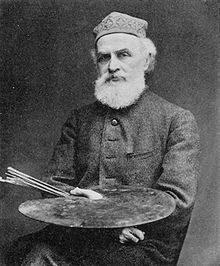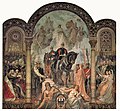Hermann Wislicenus
Hermann Wislicenus (born September 20, 1825 in Eisenach , † April 25, 1899 in Goslar ) was a German painter .
Live and act
Wislicenus went to the art academy in Dresden in 1844 and later became a pupil of Eduard Bendemann , then Schnorr . His first painting Abundance and Misery was bought for the Dresden gallery ( cardboard in the museum in Leipzig). In 1853 he went to Italy with a travel grant, where he particularly followed Peter von Cornelius in Rome (see also Nazarenes ).
After his return he settled in Weimar and opened a large studio. He worked here until 1868 and was highly valued by both critics and audiences. In the spring of 1868 Wislicenus accepted a call as professor for history painting at the academy in Düsseldorf .
Within the Kunstakademie Düsseldorf, a majority formed against the appointment of Wislicenus, who was known as a representative of an idealistic and Prussian-national romantic art conception. Many students and professors, including Eduard Bendemann, who held the chair for history painting until 1867, supported Wilhelm Sohn , an artist of the realistic direction and nephew of the late academy professor Karl Ferdinand Sohn , for the appointment to this teaching post , which was a profile building for the academy . The appointment of Wislicenus was finally enforced by the Prussian Ministry of Education “against the will and knowledge of the teaching staff”. Against them, against the influence of the Prussian government official Hermann Altgelt and against the shift in power that had occurred within the Düsseldorf Academy, 38 artists rose up in a letter of protest on June 23, 1869, in the year of the fiftieth anniversary of their re-establishment, in a letter of protest to the address of the Ministry of Culture, which is in the Press published and discussed nationwide. Wislicenus also made the design for the putti frieze at the Stegmann House in Weimar.
In addition to his teaching position, Wislicenus created important works such as The Four Seasons or The Lurlei . Much of this work, as well as all of Wislicenus' studies, were destroyed in the fire at the Düsseldorf Academy in March 1872 and therefore had to be carried out again, for example the picture Germania on the watch on the Rhine .
Cycle in the imperial hall of the Palatinate in Goslar
In 1877 Wislicenus received the first prize in the competition for the painting of the imperial hall in the Palatinate in Goslar with paintings from the German imperial history and legend, the execution of which occupied him until 1890. With the support of his student Franz Weinack, he painted the hall with pictures that put the Hohenzollern empire in the tradition of the Roman-German emperors . The largest picture in the middle of the room shows the apotheosis of the empire: in the center of the picture, Wilhelm I rides , behind him, also on horseback, his son and heir to the throne Friedrich Wilhelm . To the left of Wilhelm are two young women in long, light-colored robes who personify Lorraine and Alsace. Both carry their main church, the cathedral of Metz and the Strasbourg cathedral , in their hands. To Wilhelm's right stands Bismarck , the builder of the new empire.
On the left side of the picture you can see the German princes, in front the Bavarian King Ludwig II , who hands Wilhelm a crown. On the right side of the picture sit the wives of Wilhelm I and his son, Augusta and Victoria . The boy standing there is the future Kaiser Wilhelm II.
Holy Roman Emperors , including Frederick I Barbarossa, soar in the sky above the scene . Wilhelm I's mother, Queen Luise , hovers towards him from above with a crown.
The wall paintings grouped around the largest mural on the long west wall and on the narrow sides in the north and south correspond thematically to match the symmetry of the hall.
The fairy tale of Sleeping Beauty is depicted on the narrow side in the south . It is intended to symbolize that the old empire did not perish in 1806, but fell into a long sleep and was awakened when the empire was founded in 1871 . Opposite on the narrow side in the north, Friedrich I Barbarossa can be seen climbing out of the Kyffhauser with a sword in hand . In the upper right corner an eagle is flying, chasing away the ravens. In the picture, Friedrich I wears the facial features of Wilhelm I and looks in his direction.
Further on the south side: The fall of the Irminsul by Charlemagne in 772. Opposite on the north side: Luther before Charles V at the Diet of Worms in 1521.
On the west side to the left of the large painting:
- Coronation of Henry II and his wife Kunigunde by Pope Benedict VIII in 1014
- Henry III. leads the deposed Pope Gregory VI. caught across the Alps . Hildebrand, who later became Pope Gregory VII, is on the train.
- Heinrich IV. Actually, a representation of the walk to Canossa was planned at this point , but it was only shown in one of the smaller, monochrome pictures.
On the west side to the right of the large painting:
- Frederick I Barbarossa asks Heinrich the Lion for support on his fifth journey to Italy (kneeling from Chiavenna , 1176), Henry the Lion refuses
- Friedrich I. Barbarossa at the Battle of Iconium during the Third Crusade in Asia Minor
- Frederick II , in this picture Wislicenus, who was an admirer of Frederick II, also represented himself
family
Hermann Wislicenus married Ida Roederer and had four children with her, including the admiralty and naval writer Georg Wislicenus (1858–1927), the painter Max Wislicenus (1861–1957) and the painter Hans Wislicenus (1864–1939). The sculptor Lilli Wislicenus-Finzelberg (1872–1939) was his niece and later daughter-in-law.
Hermann Wislicenus died on April 25, 1899 at the age of almost 74 and found his final resting place in the Wilmersdorf cemetery (Berlin).
Picture gallery
Works (selection)
- Cardboard boxes
- Götterbacchanal , for a ceiling painting for a house in Leipzig
- Draft for a mural for the castle chapel in Weimar
- Oil paintings
- The night for the Grand Duke
- The imagination, borne by dreams , for Count Adolf Friedrich von Schack
- The four evangelists , for the grave chapel of Grand Duchess Maria Paulowna in Weimar
- The four seasons (in the Berlin National Gallery )
- Germania on the watch on the Rhine
- The lurlei
- drawings
- Hall of Fame of German Poets (in the Museum zu Weimar)
- The Deucalionic Flood (ibid)
- Prometheus saga (in the Leipzig Museum)
- Brutus' verdict and The Mother of the Gracches ( Roman House (Leipzig) )
Honors
The cities of Goslar and Ludwigshafen am Rhein each named a street in his honor.
literature
- Siegfried Gehrecke: Hermann Wislicenus 1825–1899. Erich Goltze publishing house, Göttingen 1987, ISBN 3-88452-830-0 .
Individual evidence
- ^ Wolfgang Hütt : Die Düsseldorfer Malerschule 1819–1869 . VEB EA Seemann Buch- und Kunstverlag, Leipzig 1984, p. 250 ff.
- ^ Karl Woermann : On the history of the Düsseldorf Art Academy , Düsseldorf 1880, p. 18
- ↑ s. a. Schack Gallery in Munich.
Web links
- Literature by and about Hermann Wislicenus in the catalog of the German National Library
| personal data | |
|---|---|
| SURNAME | Wislicenus, Hermann |
| BRIEF DESCRIPTION | German painter |
| DATE OF BIRTH | September 20, 1825 |
| PLACE OF BIRTH | Eisenach |
| DATE OF DEATH | April 25, 1899 |
| Place of death | Goslar |










